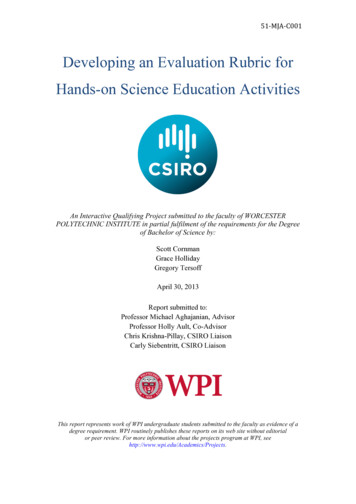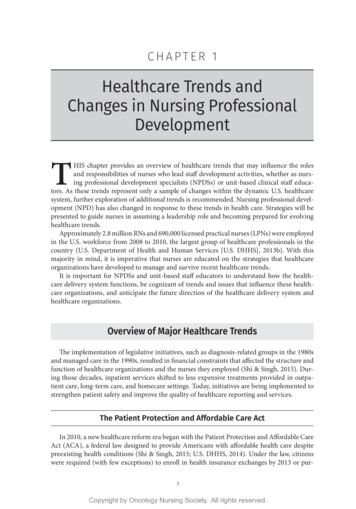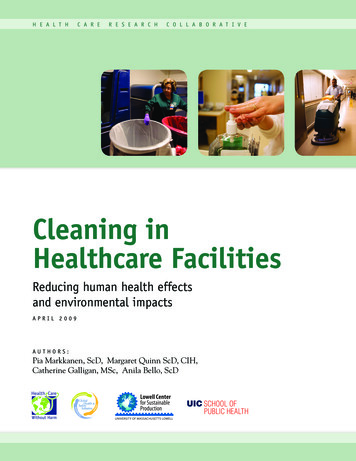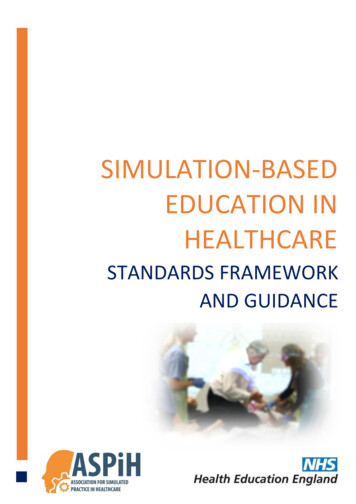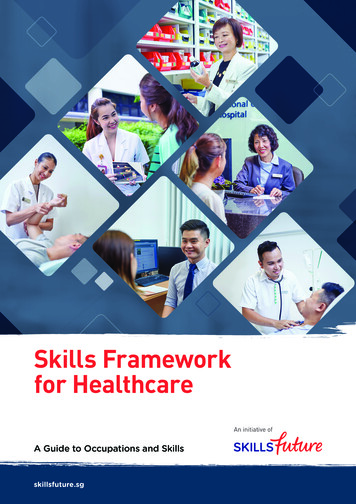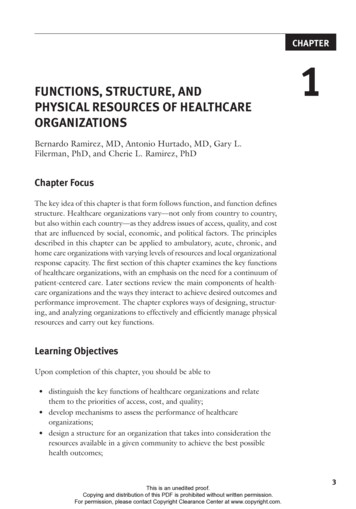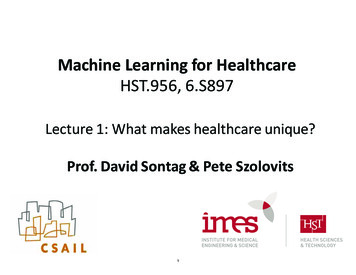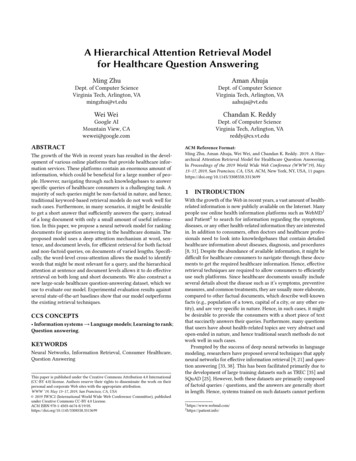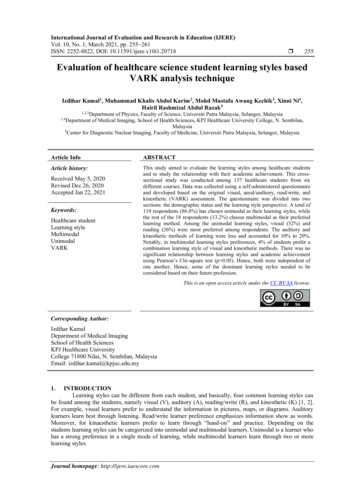
Transcription
International Journal of Evaluation and Research in Education (IJERE)Vol. 10, No. 1, March 2021, pp. 255 261ISSN: 2252-8822, DOI: 10.11591/ijere.v10i1.20718 255Evaluation of healthcare science student learning styles basedVARK analysis techniqueIzdihar Kamal1, Muhammad Khalis Abdul Karim2, Mohd Mustafa Awang Kechik3, Xinni Ni4,Hairil Rashmizal Abdul Razak51,2,3Departmentof Physics, Faculty of Science, Universiti Putra Malaysia, Selangor, Malaysiaof Medical Imaging, School of Health Sciences, KPJ Healthcare University College, N. Sembilan,Malaysia5Center for Diagnostic Nuclear Imaging, Faculty of Medicine, Universiti Putra Malaysia, Selangor, Malaysia1,4DepartmentArticle InfoABSTRACTArticle history:This study aimed to evaluate the learning styles among healthcare studentsand to study the relationship with their academic achievement. This crosssectional study was conducted among 137 healthcare students from sixdifferent courses. Data was collected using a self-administered questionnaireand developed based on the original visual, aural/auditory, read/write, andkinesthetic (VARK) assessment. The questionnaire was divided into twosections: the demographic status and the learning style perspective. A total of119 respondents (86.8%) has chosen unimodal as their learning styles, whilethe rest of the 18 respondents (13.2%) choose multimodal as their preferredlearning method. Among the unimodal learning styles, visual (32%) andreading (26%) were most preferred among respondents. The auditory andkinesthetic methods of learning were less and accounted for 10% to 20%.Notably, in multimodal learning styles preferences, 4% of students prefer acombination learning style of visual and kinesthetic methods. There was nosignificant relationship between learning styles and academic achievementusing Pearson’s Chi-square test (p 0.05). Hence, both were independent ofone another. Hence, some of the dominant learning styles needed to beconsidered based on their future profession.Received May 5, 2020Revised Dec 26, 2020Accepted Jan 22, 2021Keywords:Healthcare studentLearning styleMultimodalUnimodalVARKThis is an open access article under the CC BY-SA license.Corresponding Author:Izdihar KamalDepartment of Medical ImagingSchool of Health SciencesKPJ Healthcare UniversityCollege 71800 Nilai, N. Sembilan, MalaysiaEmail: izdihar.kamal@kpjuc.edu.my1.INTRODUCTIONLearning styles can be different from each student, and basically, four common learning styles canbe found among the students, namely visual (V), auditory (A), reading/write (R), and kinesthetic (K) [1, 2].For example, visual learners prefer to understand the information in pictures, maps, or diagrams. Auditorylearners learn best through listening. Read/write learner preference emphasizes information show as words.Moreover, for kinaesthetic learners prefer to learn through “hand-on” and practice. Depending on thestudents learning styles can be categorized into unimodal and multimodal learners. Unimodal is a learner whohas a strong preference in a single mode of learning, while multimodal learners learn through two or morelearning styles.Journal homepage: http://ijere.iaescore.com
256 ISSN: 2252-8822Nowadays, students are more interested in healthcare subjects, which led to an increase in healthcarecourses offer in most colleges, both private and government. Most of this institution is accredited andproduce an upholding the highest professionalism in healthcare education. Therefore, it is necessary to ensurethat the institutions are producing a competent future healthcare worker who prepared for the services.Notably, the process of learning during the classes plays the central role for students to be good learners andsuccess in the field. The method of students applied in the study might affect the student’s academicperformance [3]. Other than this, the teaching technique and the mode lecturers used to deliver knowledge tothe students can influence the learning interest of students.In most cases, the students did not realize his or her learning styles [4]. The students might not beidentifying which learning method is suitable for them. The learning styles may vary based on the individual.It might be changeable or will adapt based on the environmental factors they faced or located. Healthcarestudents might need various methods to learn since the students need to undergo writing tests and clinicalassessments before graduate and step into the real world of working. Several studies were previously done onlearning styles in other countries, and the outcome of the results were varied [2, 3, 5, 6]. Based on the studydone by Neha, et al., many researchers agree that the learning style can have an impact on the academicperformance of students [5].In general psychology, the term learning styles refers to learners preferred general approach tolearning, which includes the process of absorbing, processing, and retaining new information. The “learningstyles” are aimed at the process of learning of individuals. There are various models in explaining thelearning style. For example, Kolb introduced the VARK questionnaire to test the learning preferences [7].According to Fleming, as a teacher, one’s best option is to use a variety of teaching techniques to give allstudents the best chance to succeed. Furthermore, most people possess a dominant or preferred learning style;however, some people have a mixed and evenly balanced blend of the four types, which is visual, auditory,and kinaesthetic [8].Learning styles are defined as the preferences way of an individual to receive and process theinformation given. The preferences learning styles vary among the students as to how the students gain newknowledge during the class, and most of them do not realize their learning style. The main problem that hasbeen stated was the mode of the learning styles where the students prefer most, and students will get bored ifthey did not rule out their preferred learning styles. Moreover, many lecturers did not put attention andneglect on the students learning styles. Our institution, KPJ Healthcare University College (KPJUC),therefore, always wanted to provide a good study atmosphere that would understand the students need.KPJUC mainly offers six undergraduate courses in the health sciences, including a bachelor of medicalimaging (BMI), a bachelor of physiotherapy (BPT), a bachelor of pharmacy (BPH), bachelor of occupationaltherapy (BOCT), bachelor of pharmaceutical (BPS) and bachelor of nursing (BON). All classes in healthsciences include face-to-face teaching and learning through the classroom, lectures, tutorials, practicalcourses, seminars, and clinical connection to the real world. Therefore, this study aimed to evaluate thedominant learning style of healthcare students and to relate with the academic performance based on the typeof healthcare courses.2.RESEARCH METHODIn this study, the research ethics committee of our institution had approved the research protocol forthe prospective analysis with an approval ID: KPJUC/RIC/BMI/EC/2017/78. This cross-sectional study wasconducted among 191 students. The survey was conducted in the KPJUC student lounge by approachingthem using a non-probability convenience sampling technique. All participants agreed to the terms andsigned the consent form before receives the questionnaire. Of 191, only 137 participants (from six differentcourses namely, bachelor of medical imaging (BMI), bachelor of physiotherapy (BPH), bachelor ofpharmacy (BPH), bachelor of occupational therapy (BOT), bachelor of pharmaceutical (BPT) and bachelorof nursing (BON) have completed the questionnaire. For those who late and incomplete, the answer has beenexcluded from data collection.2.1. InstrumentData was collected using a self-administered questionnaire and developed and references based onthe VARK learning styles questionnaire (version 7.0) and learning styles assessment. The questionnaire wasvalidated by psychologist and divided into two sections, namely demographic status, and learning styleperspective. The first section consists of seven questions that characterize the respondents. The questionsincluded demographic data such as ages, gender, ethnicity, year of study, courses of the respondents,achieved cumulative grade points average (CGPA), and inquire the respondents it is their first time answeringthe learning styles assessment questionnaire. The second section consists of 10 multiple-choice questionsInt J Eval & Res Educ, Vol. 10, No. 1, March 2021: 255 - 261
Int J Eval & Res EducISSN: 2252-8822 257inquiring the respondents ' preferred learning styles. The four choices are related to the visual, auditory, read/write, and finally kinaesthetic mode. Each question consists of four (A, B, C or D) selection, and therespondents allow to choose more than one option as long as their selection represented within the scenario.The questionnaire was distributed in both English and Bahasa Malaysia. After validating the questionnaire,the reliability test was conducted on the questionnaire through 10% from the sample, where 20 subjectsinvolved in the reliability test with the test result score was 0.86.2.2. Statistical analysisData were analyzed using IBM SPSS version 22.0 (IBM Corporation, Armonk, New York, USA).Scores of learning styles were summed and expressed as mean and standard deviations. All the variablesinput was presented in descriptive analysis. The Kolmogorov-Smirnov test was used to determine thenormality of the data. Differences between the two groups were determined using the Mann-Whitney U Test(p 0.05), while the Kruskal-Wallis H Test was used for more than two groups (p 0.05). The meancomparisons between variables were presented descriptively. Pearson correlation analysis was used todetermine the association between learning style and subject’s CGPA grade.3. RESULTS3.1. Subject’s demographyThe respondents were characterized by gender and course groups, as presented in Table 1. Out of137 respondents, 83% were female, while 17% were male with their mean age 21.4 1.5 (range 18- 26 y/o).The highest number of respondents in this study came from group course BPT and BMI which represent 50%of all subjects as shown in Figure 1. Most of the respondents were from the age group of 21 to 23 years old(53%) and the second highest is the age from 24 to 26 years old (23%). There were 93 respondents (68%)were from Malay ethnicity followed by 32 respondents from India ethnicity, (25%) and lastly 12 respondentswith (9%) of the respondents from Chinese ethnicity. Notably, there were 70% of respondents answered thelearning styles assessment for the first time. On top of that, 61% of respondents are categorized in low academicachievers as the CGPA is lower than 3.5, and 39% of respondents scored higher in CGPA more than 3.5.Table 1. Summary of demographic among the t time answeringlearning styles assessmentMaleFemale18 to 2021 to 2324 to 26 26MalayChineseIndiaYesNon (%)23 (17)114 (83)30 (21.9)71 (53.3)31 (22.6)3 (2.2)93 (67.9)12 (8.8)32 (23.4)96 (70.1)41 (29.9)Figure 1. Percentage different of respondents based on their study courseEvaluation of healthcare science student learning styles based VARK analysis technique (Izdihar Kamal)
258ISSN: 2252-8822 3.2. Learning style assessmentA total of 119 respondents (86.8%) has chosen unimodal as their learning styles, while the rest ofthe 18 respondents (13.2%) choose multimodal as their preferred learning method. Among the unimodallearning styles, visual (32%) and reading (26%) were most preferred among students. The auditory andkinesthetic methods of learning were less and accounted for 10% to 20%. Notably, in multimodal learningstyles preferences, the most preferred method was bimodal 14 (78%), followed by trimodal 3 (17%) andquadrimodal 1 (5%) (Figure 2). Among 18 (13.2%) of students prefer a combination learning style, 14 (78%)bimodal mixed up of VK, VR, RK, AK, and AR. VK was the most preferred mode among bimodal 6 (33%)as shown in Figure 3. Visual learning styles receive the highest score for both males and females. The secondhighest percentage prefer learning styles for males was kinesthetic, but contrary to females, the otherpreferred learning style was reading/writing. Table 2 shows the percentage of the score for the preferredlearning style.Table 2. Number of respondents and percentage score in each learning stylesVARK ltimodal (VK, VR, RK, AK, and AR)Figure 2. Percentage different of respondents whopreferred multimodal learning style (n 18)n (%)44 (32.1)13 (9.5)35 (25.5)27 (19.7)18 (13.1)Figure 3. Percentage of respondents chosencombination of learning stylesTable 3 summarized the relationship between respondent from different courses and their learningstyle. A simple logistic regression was performed to define the relationship. Throughout the finding, there isno significant association between the courses and learning styles. The coefficient estimated was negative,and the variable of courses is not significant to the model (p 0.05). Table 4 tabulates the statistical analysisbetween learning styles and academic performance based. Notably, there was no significant relationshipbetween learning styles and academic performance respondents using Pearson’s Chi-square test (p 0.05).Hence, both were independent of one another.Table 3. The relationship between learning styles and different courses in KPJUCCoursesBOTBONBPTBPSBPHBMIRegression coefficient (b)0.0-19.853-0.219-0.299-0.442-19.853Wald statistic.303.000.113.213.145.000Int J Eval & Res Educ, Vol. 10, No. 1, March 2021: 255 - .000-0.000p-value.9981.000.736.644.703.998
Int J Eval & Res EducISSN: 2252-8822 259Table 4. The association between learning styles and academic performance.Learning stylesUnimodalMultimodalHigh
the VARK learning styles questionnaire (version 7.0) and learning styles assessment. The questionnaire was validated by psychologist and divided into two sections, namely demographic status, and learning style perspective. The first section consists of seven questions that characterize the respondents. The questions included demographic data such as ages, gender, ethnicity, year of study .

